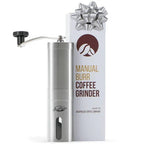For many, making espresso at home is a daily ritual. Coffee drinkers everywhere cherish waking up and preparing the perfect shot is a quiet moment of zen before the day begins.
Replicating cafe-quality espresso at home, however, requires a lot of patience, practice, and the right beans.
Beginners may think, “I need to buy espresso beans!” and sprint to their local coffee roaster, only to discover not a single bag on the shelf is an espresso bean.
Spoiler alert—there’s no such thing as an espresso bean!
Unfortunately, decades of marketing efforts have left customers confused about espresso.
Today, we’ll show you why you can use any type of coffee bean for espresso, plus:
- What espresso is (+why you should never trust a bag labeled “Espresso Beans”)
- How to select the best beans for making espresso
- Everything you need for a solid home espresso setup
What is Espresso?
After years of widespread marketing strategies from industry giants and well-known corporations, the lines of what espresso is and isn’t have blurred in the minds of consumers.
Some believe espresso is a type of bean with a super dark and smoky flavor. Others think it’s a way you roast coffee. Who’s right?
Sadly, neither. Let’s define what espresso truly is.
Espresso is...
This brewing process results in a tiny shot of coffee with abundant flavor. Espresso can be syrupy and rich with notes of caramel, vanilla, and red apple, or slick and vibrant with intensely aromatic floral notes. The possibilities are endless.
Read: What is Espresso?
Now, let’s cover everything espresso is not.
Skip the “Espresso Beans”
The next time you’re browsing the coffee aisle at the grocery store, you can confidently gloss over any bag labeled “Espresso Beans.”
However, there’s one small caveat.
A bag labeled “Espresso” means that the roaster has roasted the coffee with the intention of it being brewed as espresso.
Many roasters provide “Espresso Blends” or manipulate single origin roast profiles to coax out certain flavors during the brewing process.
When choosing between a bag labeled “Espresso Beans” and “Espresso Blend,” opt for the blend—since espresso beans do not exist!
How to Select the Best Coffee Beans for Espresso
Shopping for coffee beans can be fun and overwhelming.
There are so many blends, single origin coffees, and roasters to choose from. If you follow this quick three-step process, you’ll find the perfect beans for your home espresso drinks.
Pro Tip: if you’re unsure of your flavor preferences, take yourself on a coffee tour! Sample espressos from multiple coffee shops and ask them what beans and roaster they use. This experience will help you develop a flavor foundation for yourself.
Over time, you’ll develop an understanding of what coffee beans to choose for your ideal espresso shot.
6 Necessities for a Solid Home Espresso Setup
Making espresso at home can be as easy or as complex as you desire. Some coffee drinkers want espresso at the push of a button, whereas others want full control over the entire process.
No matter which direction you plan to take, these equipment necessities are a must.
Each piece of equipment plays a critical role in helping you pull tasty espresso shots from home.
Brew Espresso at Home
When it comes to brewing espresso at home, you can try:
- Delicate and fruity beans from Ethiopia.
- A rich, caramelly blend of coffee from Colombia and Peru.
- Coffee beans from Sumatra bursting with a stone fruit sweetness.
The options never end.

